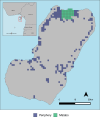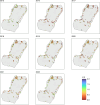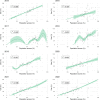This is a preprint.
The challenge of improving long-lasting insecticidal nets coverage on Bioko Island: using data to adapt distribution strategies
- PMID: 38645156
- PMCID: PMC11030524
- DOI: 10.21203/rs.3.rs-4188387/v1
The challenge of improving long-lasting insecticidal nets coverage on Bioko Island: using data to adapt distribution strategies
Update in
-
The challenge of improving long-lasting insecticidal nets coverage on Bioko Island: using data to adapt distribution strategies.Malar J. 2024 Oct 29;23(1):324. doi: 10.1186/s12936-024-05139-y. Malar J. 2024. PMID: 39472916 Free PMC article.
Abstract
Background: Since 2015, malaria vector control on Bioko Island has relied heavily upon long-lasting insecticidal nets (LLIN) to complement other interventions. Despite significant resources utilised, however, achieving and maintaining high coverage has been elusive. Here, core LLIN indicators were used to assess and redefine distribution strategies.
Methods: LLIN indicators were estimated for Bioko Island between 2015 and 2022 using a 1×1 km grid of areas. The way these indicators interacted was used to critically assess coverage targets. Particular attention was paid to spatial heterogeneity and to differences between urban Malabo, the capital, and the rural periphery.
Results: LLIN coverage according to all indicators varied substantially across areas, decreased significantly soon after mass distribution campaigns (MDC) and, with few exceptions, remained consistently below the recommended target. Use was strongly correlated with population access, particularly in Malabo. After a change in strategy in Malabo from MDC to fixed distribution points, use-to-access showed significant improvement, indicating those who obtained their nets from these sources were more likely to keep them and use them. Moreover, their use rates were significantly higher than those of whom sourced their nets elsewhere.
Conclusions: Striking a better balance between LLIN distribution efficiency and coverage represents a major challenge as LLIN retention and use rates remain low despite high access resulting from MDC. The cost benefit of fixed distribution points in Malabo was deemed significant, providing a viable alternative for guaranteeing access to LLINs to those who use them.
Keywords: LLIN indicators; coverage; long-lasting insecticidal nets; malaria; malaria indicator survey; mass-distribution campaign.
Conflict of interest statement
Competing interests The authors declare that they have no competing interests.
Figures












References
-
- WHO. World Malaria Report 2019. World Health Organization; 2019.
-
- Koenker H, Worges M, Kamala B, Gitanya P, Chacky F, Lazaro S, et al. Annual distributions of insecticide-treated nets to schoolchildren and other key populations to maintain higher ITN access than with mass campaigns: a modelling study for mainland Tanzania. Malaria Journal. 2022;21(1):246. - PMC - PubMed
Publication types
Grants and funding
LinkOut - more resources
Full Text Sources

